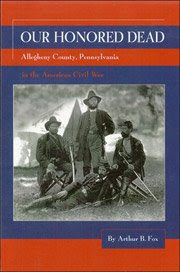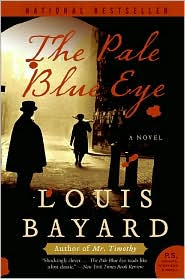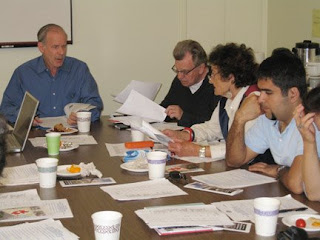 Union Soldier's Remains Found at Antietam
Union Soldier's Remains Found at Antietam, Linda Wheeler, Washington Post, December 28, 2008.
The soldier was just a teenager. Somewhere in New York state, he had signed up to fight for the Union. The band was playing on the day he marched away from home, headed South to to kill those rebels. Everyone said it would be a short war. He'd be home in no time. All of that ended on Sept. 17, 1862 at Antietam when he and his comrades were crossing a farmer's field. A bullet or piece of shrapnel found him. He sagged to the ground and was dead. His buddies moved on; they had to. The fighting was intense. By the end of the day, the battle considered the bloodiest of the war would end with 23,000 casualties.
The next day, under a flag of truce, a Union burial detail began its grim work. Sometime in the next week, the New Yorker was put in a shallow grave near where he fell, but away from the the farmer's plow. He was buried near a limestone outcropping that rippled just above the surface. This was temporary. Either his family or the government would move him to a cemetery and give him a proper burial. No one ever came for him. His grave was overlooked when the Union dead were gathered and moved to the new Antietam National Cemetery, dedicated exactly five years after the battle.
For 146 seasons, crops were planted all around him and even over him if a farmer could make the tight turn at the rocky place, but nothing disturbed his sleep. He could have been there forever, never found and never known except for a ground hog who happened to build a tunnel at that spot. The tunnel was deep, angling down under the limestone. At some point, the tunnel became clogged with debris and the ground hog vigorously kicked it out of the way, flinging it all the way to the surface. It included pieces of tea-colored bone. A visitor who was walking the battlefield in mid-October,strayed off the Corn Field Trail and saw some bones on the ground that he later left at the visitors' center. He didn't give his name, saying only he had found something in a field off the trail, next to an animal hole.

"It was a jaw bone with four teeth attached and one loose plus some other fragments," said Ed Wenschhof Jr., Antietam's chief of Natural Resources Management and Resources Protection. "We get a lot of these bones brought in here, almost all of them are animal." He needed to check it out. Several photographs were emailed to the National Park Service's regional archaeologist, Stephen Potter, in Washington. Potter said he knew right away the jaw, and what turned out to be skull fragments, belonged to a human. And he knew they were very old bones.
"When I realized what I had -- an unmarked, unknown burial of a Civil War soldier, not a victim of modern mayhem -- it grabbed me in the gut," he said. "I was totally focused. I forgot everything else. I immediately started planning what we would do next." He said he estimated the soldier's age at 19 to 21, based on an impacted wisdom tooth in the jaw bone, the lack of wear on the teeth and an open suture in the cranium. That suture closes only when an individual ceases to grow. He called Wenschhof. Potter wanted to see the the bones but his first impulse was to collect whatever else was out there in the field. It was going to be difficult to find the spot. The field covered acres of land, but they had to move quickly because relic hunters might hear about the discovery and disturb the grave.
Wenschhof and a team of park rangers crisscrossed the field that was adjacent to the infamous Corn Field, where brutal hand-to-hand fighting had taken place during the battle. There were burrows everywhere, and they had to be careful not to step in to them. Finally, one of the team found bone fragments and several pieces of leather outside a ground hog hole. It had to be the right place. The soldier had been found. Potter had sent the photographs to Douglas Owsley, a well-known forensic anthropologist with the Department of Anthropology at the Smithsonian Institution. He agreed with Potter's assessment but felt the soldier was somewhere between 18 and 21 and most likely was a teenager.
"He said the kid never saw his 20th birthday," Potter recalled. Within a few weeks, Potter and a crew were at Antietam, also known as Sharpsburg, scraping away the top layer of brown earth and then delving into the reddish layer of clay. They were working under a blue and white tent erected to shield themselves from the rain and wind and to protect whatever they found. Two animal holes were within the the rectangle sketched on the earth, probably boundaries of the grave. The resident of the burrow had been captured a few days earlier and delivered to a new neighborhood beyond the field.
The excavation work was slow. There weren't any large bones in the grave shaft. "Ground hogs can do a lot of damage," Potter said. "Context means everything. if the bones are moved or damaged or if the ground hog gnawed on them, and ground hogs do gnaw on bones -- they need their daily calcium supplement -- things can be hard to figure out." In this case, the ground hog had destroyed most of the soldier's bones.
What they did find was a number of jacket or coat buttons that connected the soldier to a New York regiment. The ones from the cuffs had the state emblem and some of the larger ones from the front had the emblem and the Latin word, "Excelsior," meaning upward. The other buttons found were general government issue, indicating the soldier was not a green recruit but a veteran who had been around long enough to have replaced lost buttons. They also found a belt buckle with "U.S." engraved on it, and some bits of leather later identified as coming from boots or shoes.

Potter told the crew, "We now know three things: our soldier was a young guy, probably a teenager, but he was a veteran and not a new recruit and he was part of a New York regiment." The crew, having plotted the exact position on paper of every bit of metal and bone and leather taken from the grave site, filled the 18-inch-deep excavation and tried to make it look like just another part of the farmer's field. The next step is for Owsley to examine all the bones and items found in the grave to see if he can tease any more information from them. He won't be able to do that for several months.
John Howard, Antietam battlefield superintendent, had been following the progress of the search closely. He had come out to watch the crews excavating the grave. Later he said it was unlikely the solider would ever be identified because so little was known about him and, on the day of the battle, there were many New York regiments involved. One of the rangers who works for Howard, Brian S. Baracz, has studied the battle for 10 years. He said there had been 68 infantry regiments, 12 artillery and seven cavalry units from New York at Antietam. Close to the area where the soldier was found, two dozen New York infantry regiments had crossed through. Using just those 24 units and narrowing the list of possible soldiers to those of the right age who were listed as "missing," he said the number would range between 25 and 50.
Howard said if they ever got "really lucky and identified the soldier, we'd make a real effort to track down the next of kin. We'd ask them what they wanted us to do. We could ship the remains or give him a proper burial here at Antietam." If there is no identification, he expects the soldier will be buried in the New York section of the national cemetery, which is near his office. "Just like any other American soldier, we will give him a proper burial," he said. "This is where he fought. This is where he died. This is now his home."
Text, Top and Middle Images Source:
Washington Post, December 26, 2008Bottom Image Source:
Through the Cornfield, Keith Rocco. Keith Rocco is among the very best artists working in the field of American Civil War and Napoleonic Era painting. He as two published collections of his work,
On Campaign: The Civil War Art of Keith Rocco, and
The Soldier's View: The Civil War Art of Keith Rocco
 On this day in ...
On this day in ... ... 1949 (60 years ago today), the British Nationality Act 1948 came into effect. It created the designation "Citizen of the United Kingdom and Colonies," which enabled certain citizens of Commonwealth countries to hold citizenship in their own countries and in the Commonwealth of Nations, the entity whose flag is at left.
... 1949 (60 years ago today), the British Nationality Act 1948 came into effect. It created the designation "Citizen of the United Kingdom and Colonies," which enabled certain citizens of Commonwealth countries to hold citizenship in their own countries and in the Commonwealth of Nations, the entity whose flag is at left. 















































